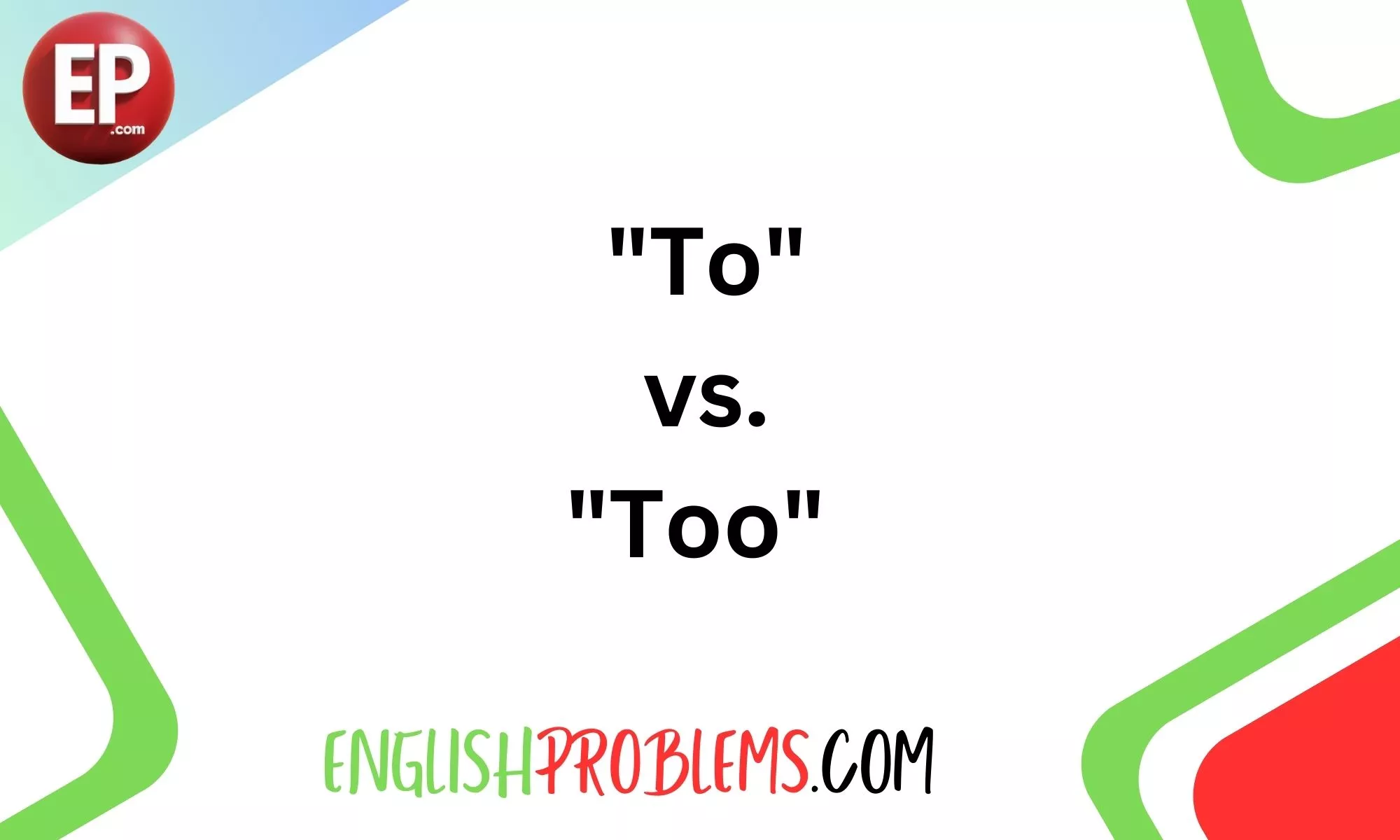English grammar can be tricky, especially when it comes to words that sound alike but have different meanings. “To” and “too” are two such words that often cause confusion. Understanding the differences between them and knowing how to use them correctly can greatly improve your writing and communication skills.
In this blog post, we’ll dive deep into the definitions, usages, and common mistakes associated with “to” and “too,” providing you with clear examples and practical tips to master these words.
Understanding the Basics: To vs. Too
Before we delve into the details, it’s crucial to grasp the fundamental differences between “to” and “too.” Both words are essential in English, but they serve distinct functions.
- To: A preposition used to indicate direction, place, or position. It also forms part of infinitive verbs.
- Too: An adverb used to indicate excess or addition.
Quick Comparison Table
| Word | Part of Speech | Main Functions | Examples |
| To | Preposition | Direction, destination, infinitives | To the store, To eat |
| Too | Adverb | Excess, addition | Too hot, I want to go too |
The Definition and Usage of ‘To’
“To” as a Preposition: Indicating Direction and Destination
“To” is primarily used as a preposition to indicate direction or destination. It’s one of the most frequently used words in the English language.
- Examples:
- I’m going to the store.
- He sent the letter to his friend.
In these sentences, “to” indicates the direction or destination of the action.
“To” in Infinitive Forms: Expressing Purpose or Action
“To” also forms part of infinitive verbs, which are used to express purpose or action.
- Examples:
- I love to read.
- She wants to learn.
Here, “to” is followed by a base verb (read, learn) to form an infinitive, indicating the action or purpose.
Identifying When to Use ‘Too’
“Too” is an adverb that serves two primary functions: indicating excess and indicating addition.
“Too” as an Adverb: Indicating Excess
When “too” is used to indicate excess, it suggests that something is more than necessary or desirable.
- Examples:
- The soup is too hot.
- She arrived too late.
In these sentences, “too” modifies the adjectives (hot, late) to indicate an excessive degree.
“Too” as an Adverb: Indicating Addition
“Too” can also mean “also” or “in addition.”
- Examples:
- I want to go too.
- She can come too.
Here, “too” suggests an addition, meaning “also.”
Common Mistakes and How to Avoid Them
Many people confuse “to” and “too,” leading to common grammatical errors. Here are some tips to avoid these mistakes:
Frequent Errors
- Using “to” when “too” is correct, and vice versa.
- Omitting “too” in sentences where it should indicate addition.
Tips for Remembering the Differences
- Mnemonic Devices:
- Remember that “too” has an extra “o” because it means “in addition” or “excess.”
- Associate “to” with movement or direction.
Practice Exercises
- Fill in the blanks with “to” or “too”:
- I’m going ___ the market.
- The cake is ___ sweet.
- She wants ___ join the team.
Answers:
- to
- too
- to
Grammar in Action: Examples of ‘To’ and ‘Too’
Seeing “to” and “too” in action can help reinforce their correct usage. Let’s look at some real-life sentences and break down their meanings.
Contextual Examples
- To:
- I need to talk to you. (Indicating purpose and direction)
- We drove to the beach. (Indicating destination)
- Too:
- I’m too tired to continue. (Indicating excess)
- You can come too. (Indicating addition)
Comparison of Similar Sentences
- She wants to eat. vs. She wants to eat too.
- The first sentence indicates a desire to perform an action (eat).
- The second sentence indicates addition (also wants to eat).
Exploring Different Contexts: Prepositions and Adverbs
“To” in Various Contexts
“To” can be used in numerous contexts beyond indicating direction and infinitives.
- Examples:
- To the left: Indicating direction.
- To be honest: Introducing an infinitive phrase expressing honesty.
“Too” in Different Scenarios
“Too” can appear in various situations to indicate excess or addition.
- Examples:
- Too much: Indicating an excessive amount.
- Too little: Indicating insufficient amount.
- Too good to be true: Indicating something is so good it’s hard to believe.
Situational Use: ‘To’ in Infinitives
Infinitives play a vital role in English grammar, often introduced by “to.”
Detailed Look at Infinitive Verbs
Infinitive verbs are formed by placing “to” before a base verb. They can act as nouns, adjectives, or adverbs.
- Examples:
- To run is fun. (Noun)
- She has a book to read. (Adjective)
- He came to help. (Adverb)
How “To” Functions in Infinitives
In these examples, “to” introduces the infinitive form of the verb, indicating the action or purpose.
The Tricky Part: ‘Too Funny’ Explained
What “Too Funny” Really Means
The phrase “too funny” often confuses people because “too” indicates excess, but in a humorous context, it means extremely funny.
- Example:
- That joke was too funny. (The joke was extremely funny)
How Context Influences Meaning
Understanding “too funny” depends on context. It implies that something is funny to an extreme degree, possibly overwhelming.
- Example:
- The movie was too funny to watch without laughing the whole time.
Words that Sound Alike: Homophones in English
Homophones are words that sound alike but have different meanings and spellings. “To,” “too,” and “two” are classic examples.
Importance of Context in Distinguishing Homophones
- Examples:
- To: Indicating direction or purpose.
- Too: Indicating excess or addition.
- Two: The number 2.
Breaking Down Homophones: To, Too, and Two
Detailed Comparison
| Homophone | Meaning | Examples |
| To | Preposition or part of infinitive verbs | To the park, To sing |
| Too | Adverb indicating excess or addition | Too much, I want to go too |
| Two | Number 2 | I have two apples |
Usage Examples and Common Errors
- To:
- Correct: We need to talk.
- Incorrect: We need too talk.
- Too:
- Correct: I ate too much.
- Incorrect: I ate to much.
- Two:
- Correct: She has two cats.
- Incorrect: She has to cats.
Pronunciation vs. Spelling: How to Tell Them Apart
Tips for Correct Pronunciation
- To: Pronounced as “tə” or “to͞o.”
- Too: Pronounced as “to͞o.”
- Two: Pronounced as “to͞o.”
Visual and Auditory Cues for Spelling
- To: Think of “to” as a short connector.
- Too: Remember the extra “o” for “extra” or “also.”
- Two: Associate “two” with the number 2.
Exercises to Improve Accuracy
Practice distinguishing between “to,” “too,” and “two” with these exercises:
- Choose the correct word:
- I have ___ dogs. (to/too/two)
- She is going ___ the store. (to/too/two)
- He eats ___ much candy. (to/too/two)
Answers:
- two
- to
- too
Memory Tips for Accurate Homophone Use
Fun and Effective Mnemonic Devices
- Too:
- Remember “too” means “also” by thinking of the extra “o” as an addition.
- To:
- Think of “to” as a short word for a short direction.
- Two:
- Visualize the number “2” to remember “two.”
Practice Drills and Quizzes
- Create flashcards with sentences that use “to,” “too,” and “two” correctly and incorrectly. Quiz yourself regularly.
Daily Habits for Mastering Homophones
- Read daily and pay attention to the usage of “to,” “too,” and “two” in context.
- Write sentences using each word to reinforce their meanings.
Advanced Tips: Mastering Grammar in Humorous Writing
How Grammar Enhances Humor
Good grammar is crucial in humor, as it ensures your jokes are clear and effective.
- Example:
- She was too funny for words. (Correct grammar makes the humor clear)
Examples of Humorous Writing with Correct Usage
- Example:
- He told a joke that was too funny to ignore.
Tips for Aspiring Writers
- Read humor: Study how comedians and humor writers use grammar.
- Practice writing jokes: Pay attention to the structure and flow.
- Seek feedback: Share your writing and get constructive criticism.
Conclusion: Perfecting Your Grammar Skills
Mastering the use of “to” and “too” can significantly improve your English writing and speaking. By understanding their definitions, usages, and differences, you can avoid common mistakes and communicate more effectively. Practice regularly, use the tips provided, and soon you’ll find that using “to” and “too” correctly becomes second nature. Happy writing!
Additional Resources
- Grammar Books: “The Elements of Style” by Strunk and White.
- Online Tools: Grammarly, Hemingway App for writing assistance.
- Practice Websites: Purdue OWL, Khan Academy for grammar exercises.

Matthew Porter brings a wealth of knowledge and a vibrant enthusiasm for teaching English to the table. His innovative approach and creative explanations make even the most challenging language concepts accessible and fun. Matthew’s dedication to helping others achieve fluency is evident in every piece he writes.










